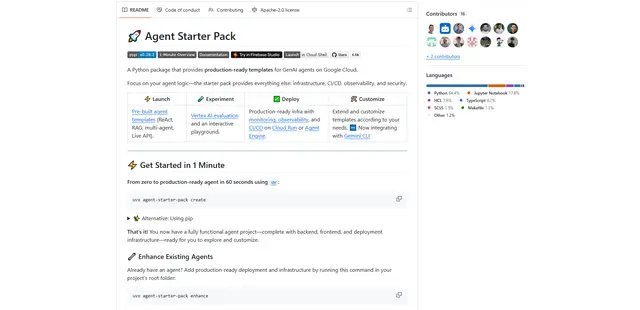API Fabric
API Fabric è un generatore di applicazioni alimentato da intelligenza artificiale che aiuta a creare API e frontend descrivendo i requisiti dell'applicazione tramite prompt in linguaggio naturale.
https://apifabric.ai/?utm_source=aipure

Informazioni sul Prodotto
Aggiornato:Jun 16, 2025
Cos'è API Fabric
API Fabric è uno strumento innovativo che combina intelligenza artificiale con lo sviluppo di API per semplificare il processo di creazione di applicazioni web. Fornisce una piattaforma in cui gli sviluppatori possono generare sia API backend che interfacce frontend semplicemente descrivendo i requisiti della loro applicazione in linguaggio naturale. La piattaforma sfrutta tecnologie standard del settore e offre componenti open-source che abilitano possibilità di personalizzazione illimitate.
Caratteristiche principali di API Fabric
API Fabric è un generatore di API e applicazioni alimentato da AI che aiuta a creare applicazioni complete (sia API che frontend) attraverso descrizioni in linguaggio naturale. Sfrutta l'AI generativa per progettare e implementare applicazioni, supporta lo standard di settore JSON:API, include livelli di logica aziendale per le regole sui dati e offre componenti open-source per la personalizzazione. La piattaforma si integra con più stack tecnologici tra cui React-admin, Angular Ontimize Frontend, backend Python e vari database.
Generazione Alimentata da AI: Utilizza il backend GPT per generare API e frontend basati su descrizioni in linguaggio naturale dell'applicazione desiderata
Conformità a JSON:API: Implementa le specifiche JSON:API standard di settore per un'integrazione frontend senza soluzione di continuità e compatibilità
Stack Tecnologico Flessibile: Supporta più tecnologie frontend e backend tra cui React, Angular, Python e vari database come SQLite, Postgres, MySQL
Integrazione della Logica Aziendale: Include un livello di logica aziendale dedicato per implementare e gestire regole e convalide dei dati
Casi d'uso di API Fabric
Sviluppo API Rapido: Genera rapidamente API per nuove applicazioni senza una codifica manuale estesa, ideale per startup e sviluppo di MVP
Modernizzazione dei Sistemi Legacy: Converti database esistenti in API moderne con interfacce frontend per aggiornamenti di sistemi legacy
Soluzioni Aziendali Personalizzate: Crea sistemi backend su misura con regole aziendali specifiche e controllo degli accessi per applicazioni aziendali
Vantaggi
Sviluppo rapido delle applicazioni attraverso generazione alimentata da AI
Supporto flessibile e ampio dello stack tecnologico
Componenti open-source che consentono una personalizzazione illimitata
Svantaggi
Potrebbe richiedere competenze tecniche per la personalizzazione e il deployment
Dipendenza da servizi AI esterni per le funzionalità di generazione
Come usare API Fabric
Installa Fabric: Scarica e installa Fabric da GitHub (repository danielmiessler/fabric) seguendo le attuali istruzioni di installazione fornite nel README
Configura la chiave API: Ottieni una chiave API OpenAI e configurala per l'uso con Fabric. Questo è necessario per accedere alle capacità di intelligenza artificiale
Scegli un Pattern: Seleziona uno dei Pattern predefiniti (AI prompts) dalla collezione di Fabric che corrisponde al tuo caso d'uso, oppure crea un Pattern personalizzato
Esegui il Pattern: Utilizza lo strumento da riga di comando fabric per eseguire il tuo Pattern scelto sui tuoi dati di input. Ad esempio: 'yt --transcript [URL] | fabric --pattern summarize' per riassumere un video di YouTube
Personalizza i Pattern: Crea i tuoi Pattern personalizzati definendo specifici prompt e casi d'uso che risolvono i tuoi problemi particolari
Integra con le Applicazioni: Utilizza il framework Fabric per integrare le capacità di intelligenza artificiale nelle tue applicazioni e flussi di lavoro esistenti
Esegui il tuo server AI (Opzionale): Per un controllo e una privacy aggiuntivi, puoi opzionalmente configurare ed eseguire il tuo server AI invece di utilizzare i servizi cloud predefiniti
Rivedi l'Output: Controlla i risultati generati dal Pattern e affina il tuo approccio se necessario regolando i pattern o i dati di input
FAQ di API Fabric
API Fabric è un generatore di API alimentato da intelligenza artificiale che aiuta a creare applicazioni (sia API che frontend) descrivendo l'applicazione in prompt. Include funzionalità per generare API e frontend utilizzando l'IA o database esistenti.
Post Ufficiali
Caricamento...Articoli Popolari

Tendenza Foto Natalizie AI 2025: Prompt Virali, Generatori Gratuiti e Come Creare Splendide Foto Natalizie AI
Dec 23, 2025

ChatGPT Image 1.5 contro Nano Banana Pro: La battaglia per il miglior generatore di immagini AI nel 2025
Dec 18, 2025

ChatGPT Image 1.5 è qui: All'interno del nuovo modello di generazione di immagini AI di OpenAI nel 2025
Dec 18, 2025

OpenAI GPT-5.2 contro Google Gemini 3 Pro: Ultima Recensione 2025
Dec 18, 2025
Analisi del Sito Web di API Fabric
Traffico e Classifiche di API Fabric
0
Visite Mensili
-
Classifica Globale
-
Classifica di Categoria
Tendenze del Traffico: Oct 2024-Jun 2025
Approfondimenti sugli Utenti di API Fabric
-
Durata Media della Visita
0
Pagine per Visita
0%
Tasso di Rimbalzo degli Utenti
Principali Regioni di API Fabric
Others: 100%







